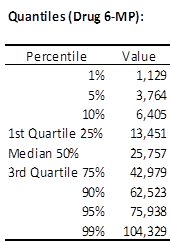Parametric survival curves analysis in Excel tutorial
This tutorial will show you how to draw and interpret parametric survival curves in Excel using the XLSTAT add-on statistical software.
Dataset to run a parametric survival curves analysis
The data have been obtained in [Gehan E.A. (1965). A generalized Wilcoxon test for comparing arbitrarily singly-censored samples. Biometrika, 52, pp 203—223] and represent a randomized clinical trial investigating the effect of the drug 6-mercaptopurine on remission times (in weeks) of acute leukemia patients.
Our goal is to determine if the failure time of the patients follows a Weibull distribution and to compare groups of patients.
Setting up a parametric survival curves analysis
After opening XLSTAT, select the XLSTAT / Survival analysis / Parametric survival curves command.

Once you've clicked on the button, the parametric survival curves box will appear. Select the data on the Excel sheet.
The Time data corresponds to the durations when the patients either relapsed or were censored.
The Status indicator describes whether a patient relapsed (event code=1) or was censored (censored code = 0) at a given time.
So that XLSTAT takes into account the information whether the patient belongs to the control or the treated group, we need to select the groups information.
Select the Weibull distribution.

The computations begin once you have clicked on OK. The results will then be displayed on a new Excel sheet.
Interpreting the results of a parametric survival curves analysis
The first table displays a summary of the data for the first group.

The next table gives the parameter and significance level of the intercept and scale parameter of the Weibull distribution for that group. 
We can see that these coefficients are significant.
Then, we can visualize several curves, including the survival distribution function (SDF, or survivor function, or reliability function).

All these results are also displayed for the control group.


Both coefficients are significant.

Finally, a plot comparing both groups is displayed. 
We can see that the control group has a much shorter survival time than the treated group.
The quantiles (percentiles) obtained with the Weibull distribution for each group are also displayed. The median time is equal to 25.75 for the treated group.

If explanatory variables are also included, then the parametric survival regression model can be used.
Was this article useful?
- Yes
- No